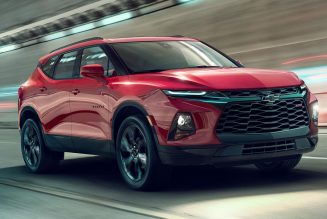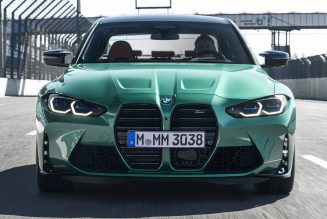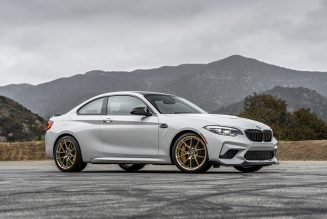If we told you there’s a new vehicle on the block with an output of 470 horsepower and 470 lb-ft of torque from a 392-cubic-inch V-8, a zero-to-60-mph time of 4.5 seconds, a quarter-mile time of 13 seconds, and that it’s an all-wheel-drive convertible, would you guess we’re talking about a Jeep Wrangler? Maybe—if we also told you the doors come off, the windshield folds down, and it still has a crawl ratio of 48:1. Meet the 2021 Jeep Wrangler Rubicon 392.
What Even Is the 2021 Jeep Wrangler 392?
After years of customer requests, the wait is over and Jeep has finally put a factory V-8 in the Wrangler for the first time, and, boy, is this one worth the wait. But before we get into driving details, we should tell you what the 392’s engineering team went through to shoehorn the V-8 into the Wrangler’s narrow engine compartment, which typically carries a V-6 or a four-cylinder.
With the same 6.4-liter Hemi V-8 and 8HP75 eight-speed automatic transmission that grace the Jeep Grand Cherokee SRT, the Wrangler 392 faces packaging challenges its larger sibling doesn’t, and that necessitates a few key changes. A redesigned front accessory drive sees the alternator move to the top of the engine, while the oil-filter mount had to be adapted to clear the front axle’s travel. New cast-iron exhaust manifolds are tucked tight to the engine, and a rear sump oil pan is fitted. The cooling module has been moved forward 20 millimeters to better manage heat, and the regular Wrangler’s 600-watt fan is now an 850-watt unit. The 392 also uses the Jeep Gladiator‘s higher-flowing grille.
To feed a steady diet of cold air to the engine while still allowing the 392 to ford deep water, the Jeep engineering team came up with the Hydro Guide induction system. Starting with a Gladiator Mojave hood, engineers removed the nonfunctional bezel and opened up the hood’s intake. They then created a pathway that takes in air but separates out water to the tune of 15 gallons a minute, ensuring neither a deluge of rain nor an errant bow wake will cause any water to reach the throttle body. Secondary air paths exist in the system to mitigate any hood-scoop blockage that might come from mud, ice, or debris, and the 392’s air filter is about three times larger than a standard Wrangler’s.
The Wrangler 392 Is a Tough Customer
In addition to the drivetrain changes, the 392 also benefits from an upgraded and reinforced frame with strategically placed stiffeners. The front frame crossmember is reshaped to clear the crank pulley and the engine mounts are also stiffer. Because the V-8 engine is so tall, Jeep increased the suspension height by another inch over the Rubicon to clear the engine.
To retain proper suspension geometry for ride and handling, the rear suspension mounts are relocated, now one inch lower for the lower arm and one inch higher for the upper. Despite boasting the tallest lift in the Wrangler portfolio, jounce travel is restricted by two inches, clearing the engine and giving the 392 the same effective jounce travel as the Wrangler EcoDiesel.
Other handling improvements come by the way of a front spring-rate increase of 10 percent, while the rear spring rate drops by 20 percent. A stiffer rear anti-roll bar helps to balance the changes and makes for a chassis that feels more planted. The Rubicon’s Tenneco monotube shocks are replaced with non-reservoir, aluminum-bodied 2.0 Fox monotube shocks.
Power flows from the 6.4-liter through the aforementioned eight-speed 8HP75 TorqueFlite automatic transmission and the Selec-Trac full-time active transfer case with 2.72:1 low range gearing. In “4 Auto” mode, the torque split has a 70 percent rearward bias and is variable up to a 50/50 split. When the transfer case is in “4 Part Time,” the torque split is 50/50 until torque to the front axle reaches its maximum output, with any additional torque going to the rear axle.
On the 2021 Jeep Wrangler 392, the front third-generation Dana 44 axle comes straight from the Gladiator Mojave with bigger brakes, thicker tubes, and cast-iron knuckles. The rear Dana 44 axle uses the bigger brakes from the upcoming Wrangler 4xe. Final-drive gearing of 3.73:1 and electronic mechanical lockers on each end round out the axle setups.
Of course, no special model from Jeep is complete without its own unique styling, so the Wrangler 392 gets bronze accents on the tow hooks, shocks, “392” hood badging, and unique bead-lock-capable 17-inch wheels wrapped in either 33-inch BFGoodrich All-Terrain KO2 or Falken Wildpeak M/T tires. The interior receives an all-black leather treatment with bronze accents and embroidered “392” logos on the heavily bolstered front seats.
How Does the Most Powerful Wrangler Drive?
With all of the work that went into the Jeep Wrangler 392, we were excited for our first drive to put it through its paces in Moab, Utah, where Jeep planned a reasonably difficult drive route. From highway and fast dirt roads to sand dunes and rock crawling, this was probably one of the more challenging new-vehicle-launch routes we’ve been on in recent memory.
At the push of a button, the engine barks from the aggressive dual quad-tip exhaust and you can’t help but smile. We were just a tad disappointed our test vehicles had full doors installed, so we made sure to open up the Sky One Touch top to soak in as much of that visceral V-8 melody as possible. For those who enjoy being a little stealthier, a button on the dash actuates the active flap in the exhaust and makes it quite subdued in “quiet” mode.
On the road, this feels like the best riding and handling Jeep Wrangler to date. The 392 has great road feel, is incredibly comfortable, and is not at all sloppy. When you stomp the accelerator pedal, the 392 flat out gets on it, pushing occupants back in a way no Wrangler ever has before. Also, just like in the Grand Cherokee SRT, the transmission performs wonderful throttle blips as it makes impressively quick downshifts, and you find yourself playing with the metal paddle shifters just to hear the engine and gearbox dance together.
Wrangler 392: Off-Road Time
While all the on-road stuff is fun, it’s not really what the new Wrangler 392 or this first drive is about. For it to really come into its own, you have to be in the dirt, where the 392 transforms into an adrenaline-inducing enabler of off-road hooliganism. Sand dunes were our favorite terrain, where it was seemingly impossible for the 392 to get stuck. No matter how deep the sand was, the 2021 Jeep Wrangler 392 used brute force to power its way forward, throwing enormously entertaining curtains of sand skyward.
Smooth dirt roads become a personal drifting course as the chassis allows you to steer with the throttle, especially when Off-Road+ is activated and the electronic stability-control button is held down until you hear the magic tone that indicates you’re off the leash. It might be weird to say of a solid-axled vehicle on off-road tires, but the 392 is a driver’s machine. It is so well dialed, it actually encourages you to manhandle it without overzealous nannies stepping in to break up the fun.
Taking our first drive on the rocks, the Wrangler 392 crawled with the best of them, and despite not matching the Rubicon’s crawl ratio, the big V-8 did a fine job traversing hill climbs and drops. We appreciated the front-facing trail camera for seeing past the hood on high-angle climbs, and Jeep’s Off-Road Pages screen in the 8.4-inch Uconnect system delivers useful real-time information, such as pitch and roll.
It also helps that the torque converter locks in 4-Lo when the vehicle is moving, increasing torque response down low and aiding in low-speed control. We found Jeep’s off-road cruise-control system, dubbed Selec Speed Control, worked well with the larger engine. As an added bonus, you can adjust your speed using the shifter paddles, allowing you to keep your hands on the wheel.
The 2021 Jeep Wrangler 392: First Conclusions
Overall, the 392 is an amazing partner on the trail. The chassis is stiff, loves to run, and is big fun to drive. We only identified two things we think the 2021 Jeep Wrangler 392 could use to elevate it from “great” to “exceptional”: On the rocky trails, we longed for 35-inch tires. We know they fit and Jeep knows they fit; we can only imagine something better is in the works, and fortunately no work is required to run 35s other than swapping the rubber onto the existing wheels.
Shock damping represents the other nitpick. On the highway and at slow to moderate speeds in the dirt, the Fox 2.0s are great, but when you get closer to the Wrangler 392’s wheel-travel limits, holes start to appear in the performance envelope. With such a powerful drivetrain, it’s easy to build speed and get caught off guard when a series of whoops or “G-outs” present themselves mid-blast. This left us wanting more control at the limits. In front, we’d like to see improved compression or jounce control to keep the axle from blowing through travel. In back it needs a little more rebound control to slow the speed of the body moving away from the axle. We’d like to see Jeep specify reservoir shocks on such a performance-oriented vehicle.
So, what’s the bottom line? If you’re a traditionalist who wants the best, enjoys basking in the auditory delight of a large V-8 engine, and needs impressive capability, the 2021 Jeep Wrangler 392 is the Wrangler for you. At a starting price of $74,995 fully loaded (that’s about $24,000 more than the next Wrangler before options), it’s a relative bargain when you consider aftermarket 6.4-liter Hemi swaps cost somewhere in the neighborhood of $30,000-plus. For that kind of money, we’ll take a fully integrated vehicle with a full factory warranty, though we’d add those 35s and upgrade the shocks on our way home from the dealer.
| 2021 Jeep Wrangler Rubicon 392 Specifications | |
| BASE PRICE | $74,995 |
| LAYOUT | Front-engine, 4WD, 5-pass, 4-door SUV |
| ENGINE | 6.4L/470-hp/470-lb-ft OHV 16-valve V-8 |
| TRANSMISSION | 8-speed auto |
| CURB WEIGHT | 5,100 lb (mfr) |
| WHEELBASE | 118.4 in |
| L x W x H | 188.4 x 73.8 x 74.5 in |
| 0-60 MPH | 4.5 sec (mfr est) |
| EPA FUEL ECON | 13/17/14 mpg |
| ENERGY CONSUMPTION, CITY/HWY | 259/198 kWh/100 miles |
| CO2 EMISSIONS, COMB | 1.33 lb/mile |
| ON SALE | Now |







